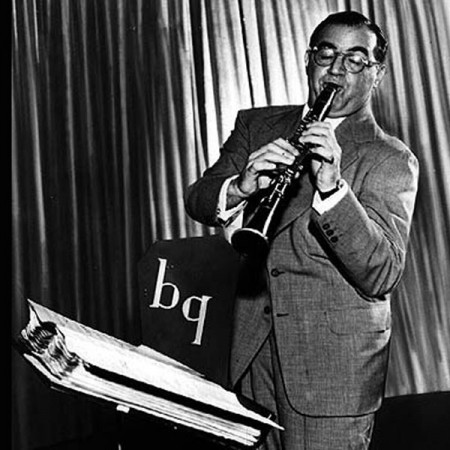
Benny Goodman
(Photo: DownBeat Archives)About 27 years have gone by since they danced in the aisles to the music of Benny Goodman and his band at the Paramount Theater in New York City. In April 1937, the New Yorker ran a profile on “one Benny Goodman.” The writer commented in wonderment on “the roar of hand clapping, whistling, stamping, and ardent hallooing” that greeted the band at the Paramount. This reception was undoubtedly one of the first of many high points in Benny’s career, and the one that finally and irrevocably established the great reputation he still retains.
Last November I played with Benny at New York’s Philharmonic Hall, and the reception he received from the packed house was not too different from the furor at the Paramount all those years ago. A shade more sedate, certainly … no dancing in the aisles … but he received a standing ovation, shouts of “bravo,” and a sustained roar of applause and whistles that must have gladdened his heart. Quite possibly there were many in the audience that night who had been among the stamping, shouting youngsters who helped cheer him at the Paramount.
Nostalgia was in the air, and the majority of the audience was, as George Avakian said, “a gleamingly pink, paunchy crowd.” If Benny ever doubted he could still captivate an audience in the old way, that night, and the many that followed on our subsequent cross-country tour, should have dispelled any doubt.
Benny Goodman is still a great name—a legend—and when he puts a band together and goes out on a concert tour, as he does two or three times a year, he evokes much of the same enthusiasm that he has been generating for the last 30 years. It is, however, to great extent, a nostalgic feeling that pervades the atmosphere. It’s nostalgia mixed with admiration that the then-skinny, dark-haired, young man with glasses—now a trim 55 and as much a master of his instrument as ever—generates. There are still flashes of sheer inspiration; and the tone, the technique, the masterly, flawless, flowing style is unchanged. Benny represents an era, a way of life, and many who come to hear him relive youth for a brief spell as they listen to the familiar mellow sound of his clarinet, the well-known arrangements with hardly a note changed.
That hardly a note is changed is one cause of complaint among some of the musicians who have worked with him in recent years. Tempers flare when new arrangements are discarded in favor of the tried and true—and to some, outdated—numbers. To these men, the Goodman legend is more a “mystique,” a sort of what-makes-Benny-run?, that is a never-ending source of discussion, which is always carried on with that enthusiasm one reserves for a subject that never lacks interest or curiosity.
Every time Benny takes out a band, there’s a fresh flood of stories and anecdotes—some humorous, some tinged with bitterness and anger, many that are probably exaggerated, but all with the unmistakable stamp of this paradoxical man who has confounded, infuriated, snubbed, irritated, thrilled, excited, amused, angered and enchanted more people than one shake a (licorice) stick at.
Now that I am an ex-Benny Goodman sideman (or, rather, sidewoman), I see that it is like being in some special order or fraternity, an in-group. We smile at each other with understanding; we listen avidly to each other’s stories of Benny’s funny little ways; we compare notes, and those of us to whom he may have been unusually caustic, inconsiderate or thoughtless can release any left-over resentment in laughter—or sympathy for someone else’s experiences. Quite often, though certainly not always, there’s an undercurrent of affection and admiration for him running through these stores, but it is mixed with the unholy glee that some musicians obviously feel when recalling and relating their adventures on the road with him.
There seems to be a general air of incredulity regarding B.G. Why does he do the things he does? And what exactly does he do or say that makes some musicians want to hurl their instruments to the floor and stomp out furiously? In a way, it’s like Chinese water torture—it doesn’t hurt, but it drives you crazy! Benny is as many-faceted as a 10-carat diamond, and, to some, he appears as cold and hard.
It has been said that at times he doesn’t show respect for the musicians who work for him, that he treats them like high-schoolers.
Teddy Wilson, who has played with Benny on and off for 30 years, sums it up with, “He doesn’t know how to explain what he wants. He acts dissatisfied, yet can’t put into words what he’d like to hear. He just knows that whatever they are doing—he doesn’t want that.”
What does Benny really want in a musician? It’s difficult to know because he never says directly. His suggestions are rather oblique. He’ll make an indirect reference to a chord change, emphasize a certain phrasing, give a quizzical look, show sudden amusement at something you don’t feel is funny. (I found his famous “ray” to be a sort of stony stare.) These, though seemingly unimportant, are, I believe, some of the things that unnerve those who play with him.
Why has Benny used this approach when a more relaxed attitude would get so much more from his musicians? The average musician is eager to play his best, and given this opportunity and a comfortable climate in which to flourish and grow, he’ll produce the best music of which he is capable. But in the rarefied atmosphere of a Goodman rehearsal, so often charged with tension, it’s enough to make the strongest ego wither from want of nourishment. Or else you rebel! I wonder if Benny realizes just how much these things are discussed, and if he does, whether he considers them important?